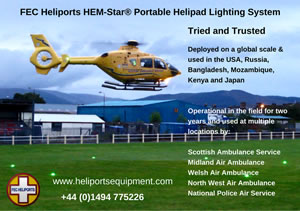Smiths Detection2010-05-19 14:38:12
Smiths Detection Launches Remote Monitoring Solution for Hazardous Gas and Vapor Identifier
Advanced HGVI LINX Software Enables Real-time Data Feeds Transmitted Out Of Danger Zones
Smiths Detection today launches HGVI LINX, a pioneering software system to help emergency responders in a central command center view and assess real-time chemical sensor data from deployed Handheld Gas & Vapor Identifier (HGVI) units. The software increases the effectiveness of incident response, reducing the time and resources needed to deliver critical information necessary to react appropriately to chemical and airborne threats.
Tim Picciotti, Vice President of Smiths Detection's Americas Military & Emergency Responder business unit, said: "The HGVI LINX software is a milestone for Smiths Detection. It is another step toward an integrated system solution, advancing and simplifying how emergency responders communicate and relay information while also increasing the utility of our technology. Integrated systems will be a growing trend for both Smiths Detection and the industry."
The HGVI is capable of detecting, identifying and quantifying toxic industrial chemicals (TICs) and chemical warfare agents (CWAs). HGVI LINX features new advanced software algorithms, GPS functionality and RF transmission technology which enhances system capability. It is capable of displaying simultaneous data readings of up to 16 HGVI units. The live readings, as well as detailed alarm and system status information, are displayed on a single command center computer located up to one kilometer away from an incident. Information is automatically superimposed over preloaded geographic maps or building diagrams as needed by each user.
Ken Fredeen, Senior Product Manager of Smiths Detection's Global Military & Emergency Responder business unit, said: "Because of the difficulty in containing gases and vapors, speed of communication is critical during a chemical threat emergency. HGVI LINX uses state-of-the-art remote monitoring technology to speed up emergency response and communication to a command center. Instead of physically needing to bring the devices back or radioing in results, emergency response teams using HGVI LINX can monitor results from outside the hot zone to increase their ability to track time-critical airborne threats."
Advanced HGVI LINX Software Enables Real-time Data Feeds Transmitted Out Of Danger Zones
Smiths Detection today launches HGVI LINX, a pioneering software system to help emergency responders in a central command center view and assess real-time chemical sensor data from deployed Handheld Gas & Vapor Identifier (HGVI) units. The software increases the effectiveness of incident response, reducing the time and resources needed to deliver critical information necessary to react appropriately to chemical and airborne threats.
Tim Picciotti, Vice President of Smiths Detection's Americas Military & Emergency Responder business unit, said: "The HGVI LINX software is a milestone for Smiths Detection. It is another step toward an integrated system solution, advancing and simplifying how emergency responders communicate and relay information while also increasing the utility of our technology. Integrated systems will be a growing trend for both Smiths Detection and the industry."
The HGVI is capable of detecting, identifying and quantifying toxic industrial chemicals (TICs) and chemical warfare agents (CWAs). HGVI LINX features new advanced software algorithms, GPS functionality and RF transmission technology which enhances system capability. It is capable of displaying simultaneous data readings of up to 16 HGVI units. The live readings, as well as detailed alarm and system status information, are displayed on a single command center computer located up to one kilometer away from an incident. Information is automatically superimposed over preloaded geographic maps or building diagrams as needed by each user.
Ken Fredeen, Senior Product Manager of Smiths Detection's Global Military & Emergency Responder business unit, said: "Because of the difficulty in containing gases and vapors, speed of communication is critical during a chemical threat emergency. HGVI LINX uses state-of-the-art remote monitoring technology to speed up emergency response and communication to a command center. Instead of physically needing to bring the devices back or radioing in results, emergency response teams using HGVI LINX can monitor results from outside the hot zone to increase their ability to track time-critical airborne threats."
For more information contact:
64 Clarendon Road
Watford
Hertfordshire
WD17 1DW
United Kingdom
Tel: +44 1923 696555
Fax: +44 1923 696559
